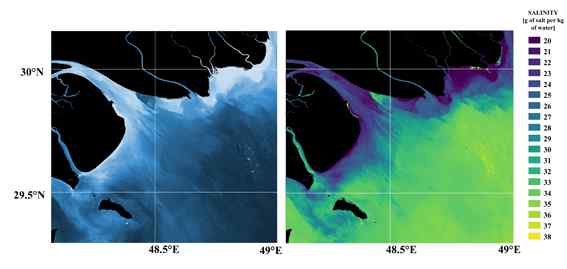Images of climate innovation
Monitoring ocean salinity from space
These satellite images show the coastal waters around the Bay of Kuwait, first in colours close to what the human eye would perceive (left) and second in colours artificially graded to represent salinity levels in the water (right). Our research provides high-resolution techniques to monitor the changing salinity of coastal areas from satellite imagery. This is critical to understand climate change and the impact of human activities on marine ecosystems.

Salinity is a crucial indicator of ocean health. Studying salinity not only helps us understand how oceans interact with land and atmosphere, it also provides crucial insights into the functioning of marine ecosystems, including key measures such as fish health, algal blooms, oxygen and organic matter distribution. It also provides valuable clues to physical processes such as estuarine mixing (the mix of water coming from rivers into the sea) and stratification (the arrangement of water in the ocean in layers depending on their density). In this image, we have derived salinity at high resolution (100 m) from multispectral images from the European Space Agency satellite Sentinel-2. Multispectral images capture, at any given time, multiple individual images at different light frequencies. These images show the results obtained when we apply a neural network to link the images taken by the satellite with in situ data (data taken with instruments in the water) from the Copernicus Marine Environmental Monitoring Service.
Entrant: Encarni Medina-Lopez , University of Edinburgh
Copyright: Encarni Medina-Lopez